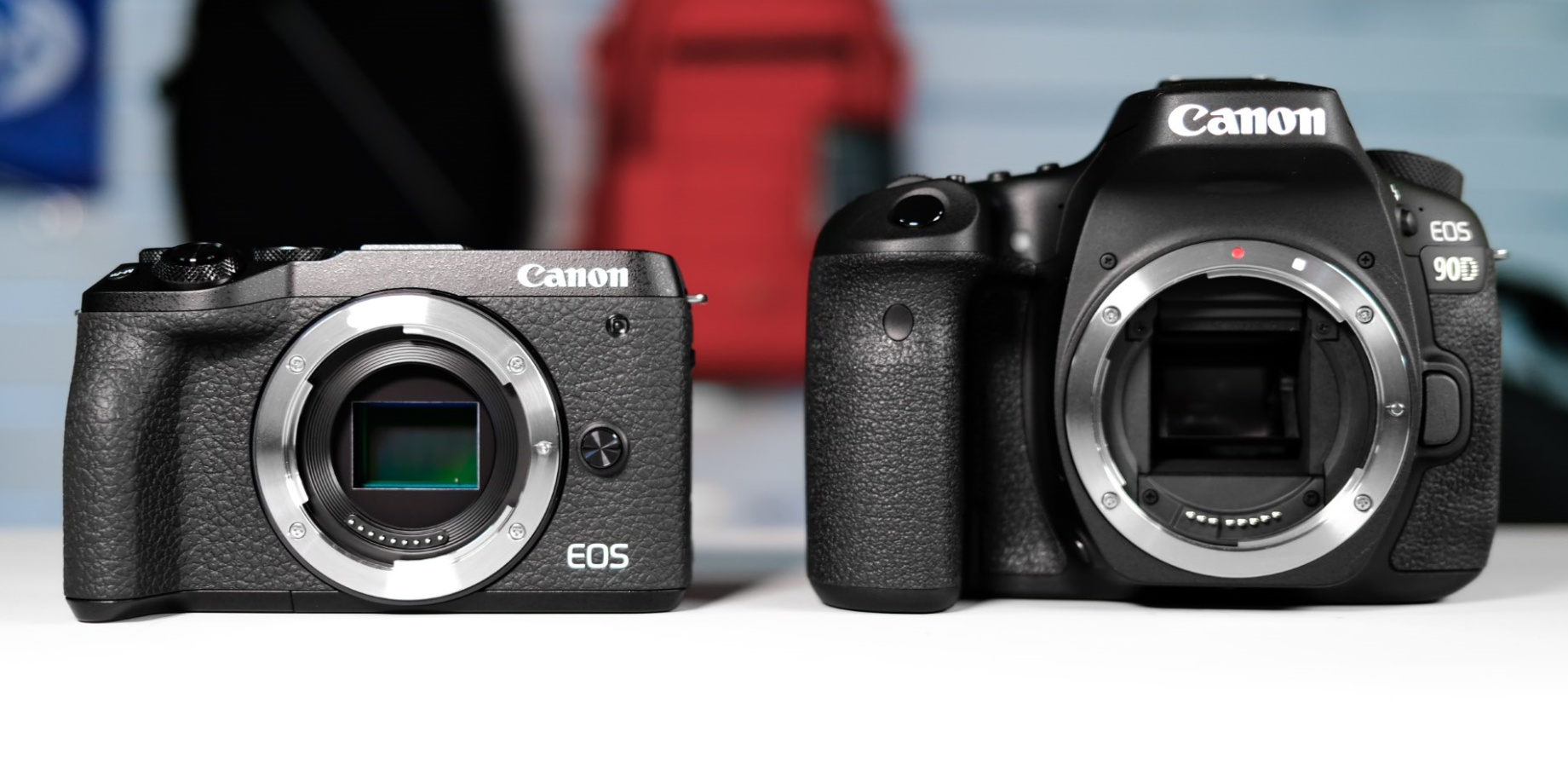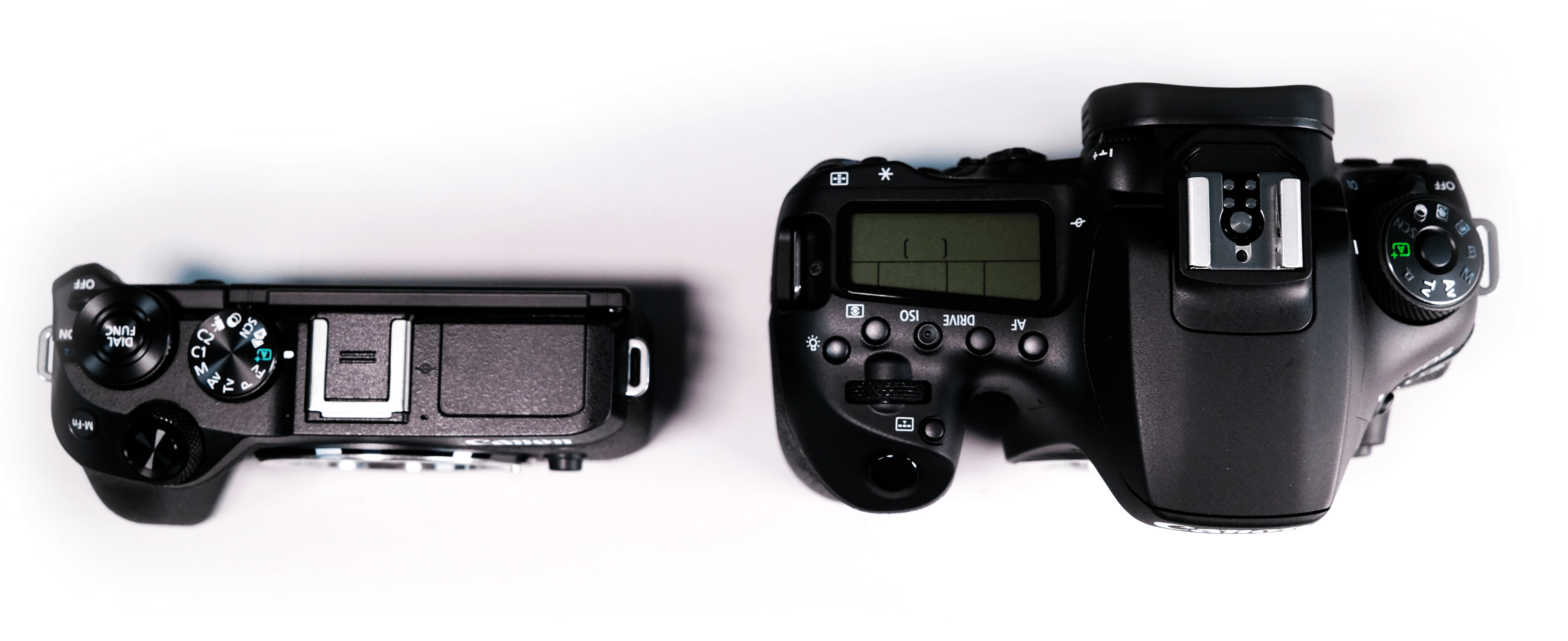Mirrorless vs DSLR - there is a winner

Mirrorless vs DSLR
Maybe 2 years ago this battle would still be ongoing, but this article is just a recap on how mirrorless cameras won the battle and what the important differences are.
Firstly, there is the clear tangible, physical difference between the two types of cameras, which we will touch on now.
As seen in the above featured image with a mirrorless on the left and a DSLR on the right. Neither camera has a body cap, so we can see directly into the camera. On the left, we are looking straight at the sensor, on the right, we have a mirror that will reflect through the eyepiece viewfinder.
From this diagram below, you can simply see that less is happening to the light on the mirrorless.


On the mirrorless, the light comes through the lens and hits the sensor. Job done
On the DSLR, the light comes through and hits a mirror which is then reflected through a pentamirror to then have that image show through the eyepiece. When you take the photo, that "main mirror" moves out of the way so the light can then directly hit the sensor and then moves back down so you can frame the next shot. (This is the SLR part of the DSLR if you wanted to look further into it)
Having an internal mirror does of course use up more real estate than having no mirror. Commonly, people bring up the size and weight difference, which is certainly relevant, but basically not always. There are simply differences in build materials across cameras that impact weight more than the fundamental design of the camera being a DSLR or mirrorless, but you tend to always have a slimmer camera in a mirrorless.
The cameras I've chosen to photograph is the Canon EOS M6 Mark II and the EOS 90D, which were both anounced on the same day, with pretty much the same internals. Just one was in a mirrorless body and the other in a DSLR. On the rare occasions where the specifications on a DSLR is identical to a mirrorless, you can certainly see the differences.


Looking at these two cameras, the amount of identical things is too long to list, so let's list the differences.
|
M6 MK II |
90D |
|
143 autofocus point |
45 autofocus points |
|
14 FPS continues drive |
11 FPS continuous drive |
|
408g |
701g |
|
Removable electronic viewfinder |
Built-in optical viewfinder |
|
305 photos shots per battery |
1300 photo shots per battery |
Other than the fact that the viewfinder is removable, every other aspect is applicable to any mirrorless vs DSLR weigh up and also makes quite a difference in performance.
So let's go from top to bottom.
Autofocus;
You may want to refer back to the internal diagram for more clarity here, but the two autofocus systems are completely different.
On a mirrorless camera, the sensor is constantly engaged, not blocked by a mirror. This then enables better tracking of faces, people, animals and a growing number of objects to be recognised by the cameras computer and then focused on without any involvement from the operator. The operator just has to point it at stuff. If the camera sees a face in the shot, it will most commonly try to focus on the eye, but will follow that face throughout the frame.
In a DSLR, there are quick options to choose where you want to focus, and it has the spread out autofocus points across most of the sensor - on this occasion, in 45 different locations - but the autofocus is determined by which area the camera operator wants to focus on. It will automatically focus on that area you choose, but you have to choose it.
Mirrorless autofocus can also get significantly better with firmware upgrades. Manufacturers are able to upgrade DSLR's as well, but the suite of things that you can change and have that camera learn in a mirrorless camera, where the sensor is constantly engaged, is much greater than the fixed hardware like in DSLR's.
Frames per second;
This one makes the most sense. To have a photo taken on a DSLR, there is a physical moving mirror that has to clear out of the way from the sensor so it can capture the image. That mirror simply isn't there on a mirrorless (duh).
There is moving shutters on mirrorless cameras, but you can look this up under mechanical vs electronic shutter.
It then relies on mainly computing parts and is much more efficient in getting these images processed. This is evident in the high-speed cameras such as Canon's DSLR the 1DX MK III which is 20FPS, Sony's latest A1 mirrorless has a 30FPS for the same price. Or if you don't like that example as the Sony A1 is over 12 months newer, compare the 1DX to the Sony A9 II, where we sell the A9 II for about $3000 less than the 1DX, but they have the same 20FPS.
So this is beneficial in not missing the moment, which is the basis of a lot of photography.
We can also take a second to consider whether you want moving parts in a small portable piece of tech that the quality of the images would be considered great for decades to come.
Weight;
This speaks for itself. If you want a lighter camera, choose a lighter camera. If you're using a camera in a studio environment with a camera constantly on a tripod, the weight doesn't really matter.
If you're looking at travelling lightweight and deciding between these two cameras, well this makes it an easy choice.
Viewfinder;
This one is also an easy one. The mirrorless is so much better.
The difference is electronic vs optical. Optical (and refer back to that diagram) is found on the DSLR where the light coming through the lens is reflected up through a couple of mirrors and then into the eyepiece like a periscope on a submarine. The sensor is only engaged once you take the photo, all the other time, you are just seeing the same light that the sensor would bounce through that viewfinder.
On an electronic viewfinder, it is just another small display in a sunshaded eye hole. The sensor is engaged and with no latency, projecting that image onto that small screen in the viewfinder. You then are able to see exactly the shot you will be taking. Rather than that exercise so many of us are familiar with when taking a photo, looking down to see the exposure is all wrong, adjusting and going again. You are able to accurately see the camera settings reflected through the viewfinder. It speeds the entire process up. Also, the mirrorless gets the entire frame in that viewfinder, where in some DSLRs it cuts off the borders so you only see about 90% of the image.
Battery life;
This is where the mirrorless loses. All that autofocusing, engaging the sensor through the viewfinder and not giving the sensor a break will mean there is always voltage running through the sensor, draining the battery.
The comparison between the M6 and the 90D is a little unfair though. The design of the M6 was all about getting it as small as possible, so Canon made the decision to put a much smaller battery in there. However, with all that space saved, you can throw in a spare battery and you have all the other benefits of a mirrorless that can't be fixed so simply. Also, looking at the price of both of these particular cameras, the M6 kit is about $200 cheaper than the 90d. So go buy a battery.
There are also battery grips available for a lot of cameras, enabling better battery life. Also on a whole, batteries are getting better and better, lasting longer and longer.
_
It would also be well worth mentioning that there have not been any flagship DSLR camera announcements in the last 12 months from any manufacture. If you currently have a DSLR, I wouldn't say you need to run out and change, but it would be an easy transition. Sony, Nikon and Canon all sell adapters for any existing lenses to get them working on a mirrorless, and they commonly use the same batteries.
If you are looking at buying a new camera, I would finally note that all the latest technological developments for cameras are going to be in a mirrorless body.


